|
|
| Whether a caterpillar really does enslave ants Laine Kristberga, Film and Art Historian Conversation with the artist Ernests Kļaviņš | |
| Ernests Kļaviņš is an artist who listens to himself, and each time this listening brings something new – it can be the image of Donald Duck or the dolphin Flipper, or just as well a sad yet disciplined Lenin in the disguise of a whistle. The artist emphasizes that a viewer shouldn’t try to read the symbolic subtext behind this imagery, because it does not exist. Instead, viewers must let their stream of consciousness flow and enjoy the impact of the vitally vibrant colours. As a caricaturist and a cartoonist, Ernests is not trying to be too serious either. Indeed, there are situations where one must be able to smile even about the horrors of war. The artist’s choice to paint on paper and on a small scale may also seem to be a sign of lack of seriousness, but it is, in fact, a need for inner freedom – to paint a lot and enthusiastically, without any fear of discarding a less successful outcome. | |
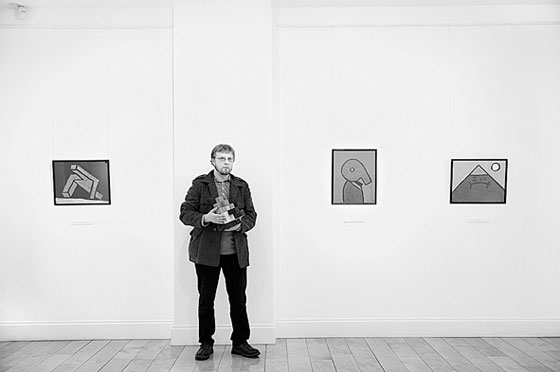 Ernests Kļaviņš. 2011 Photo: Kristaps Kalns | |
| Laine Kristberga: Referring to your exhibition at Nabaklab in 2010, you said that a painting is a non-linear narrative because it can be viewed as an entity, all in one go, or the viewer’s attention can be drawn to specific details. Cannot we draw parallels here with comics, because these also aim to provide a narrative in combination with a graphic portrayal of the plot? The only difference lies in the fact that the imagery and events are sequential. Ernests Kļaviņš: Yes, comics are totally different from paintings – their narrative is linear and the images are consecutive. L.K.: As comics also are among your creative oeuvre, could you tell us more about the comic book ‘3x3’, where you created a comic ‘The Amazing Travel in Time’ together with Andrejs Kļaviņš. E.K.: Yes, it could be described not as stream of consciousness and avant-garde, but rather as an organic tale with a beginning, a middle and an end, which I created together with my brother Andrejs, who is not an artist but studied English philology. L.K.: There have been precedents in the history of comics when a comic book has been turned into a film, for example, ‘Superman’ or ‘Sin City’. Would you like to see your comics on the big screen – either as an animation or a film? E.K.: It’s a completely different genre. Besides, I haven’t created anything so substantial that it could be cinematized. Actually, everything that has been turned into a screen version so far is total crap. If I’d grown up in American culture since I was six years old perhaps I would think differently. L.K.: In recent years the attitude towards comics has changed and academic interest in the genre has grown. Some universities even offer comic studies as an academic discipline. Comics are no longer considered the “low art”, and researchers interpret them from various standpoints – in relation to sociology, culture and anthropology. Comics nowadays are undergoing a kind of renaissance. E.K.: Yes, but I still hold the view that there is space for improvement. Within the genre of comics an art-house level also exists which, of course, must be supported. Yet the comics intended for wider audiences and environments, even those which are at the sophisticated end, for instance Watchmen, which everyone admires, fail to reach a certain level. The problem lies in the fact that comics are created by two people – one is the author of the text and the other is the designer – and then one is usually under the influence of the other. Somehow, I think, the symbiosis is not successful due to fact that the text is often poor – pretentious and too flowery, which together with poor drawings makes for a poor graphic novel! | |
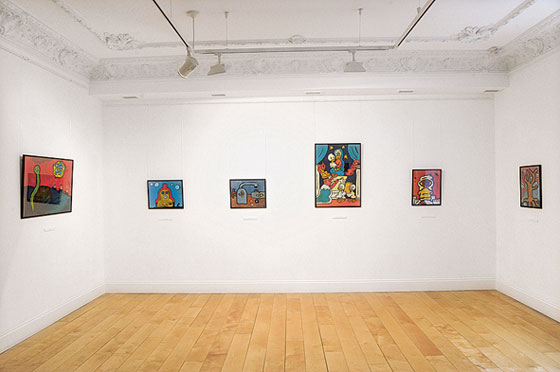 View from Ernests Kļaviņš' solo exhibition at Gallery Alma | |
| L.K.: There may be a poor story but with great visuals, or quite the opposite – there may be a terrific story ruined by bad drawings. E.K.: In that kind of situation, the terrific story cannot be appreciated! L.K.: Could you describe the situation as regards comics and comic art in Latvia? E.K.: There is Dāvids Šilters’ magazine ‘Kuš’, which is art-house and where artists are not required to tell a story, but rather to let their stream of consciousness flow. L.K.: You also provide drawings for the magazine ‘Ir’, on a regular basis. Can these be characterised as a reflection of the contemporary situation in Latvia? E.K.: I would rather define them as political commentary. L.K.: For you as a cartoonist, is it important to make the viewers laugh? Or to make them smile, at least? E.K.: Well, I don’t try too hard to make the viewers smile, but then again – my works usually don’t turn out to be deadly serious. L.K.: And how about the overall aim of comics? I recently read a statement that the goal of comics is not merely to entertain, but that it can also be a mechanism for raising public awareness. Would you agree? Could this statement, perhaps, be more appropriate in relation to your drawings as political commentaries, because they too are an attempt to address society in general? E.K.: If a drawing has been published in a newspaper or magazine as a political comment, then it must cover socially relevant subjects. However, if it is an artistic project, then I don’t want to comment on anything. An artist can definitely influence public opinion, but only if it happens naturally and without artifice, and is not imposed. L.K.: Doesn’t this provide grounds for a more general discussion on art and politics in a broader context? Indeed, there have been numerous precedents in the history of art where art and politics went hand in hand. Perhaps the most obvious example that springs to mind is Picasso’s Guernica, which is a case of political propaganda. E.K.: Propaganda in art, in my opinion, exists when art is produced to order. More as in the art of Gustavs Klutsis, for instance. But then again, he believed in what he was doing. L.K.: And what about the cartoonist’s task to hyperbolize or exaggerate? Cannot this, to a certain degree, be related to an intention to shock, which is perhaps too blatant a term? For example, the American cartoonist Robert Crumb was often reproached that his cartoons – especially if they referred to belonging to a certain race or if the sexual imagery was too explicit – were degrading. And Crumb’s comics really did quite often shock American middle-class society of the 1970s. E.K.: As a cartoonist I only express my opinion, and my opinion isn’t shocking. It’s not my intention to shock in order to make an impact. That’s what I have learnt from politics – always to react temperately, whatever is happening. For example, during the time of Kalvītis’ government it was popular to portray Kalvītis as a pig, but to me that seemed just too vicious. He was a bad politician and can largely be blamed for current problems, yet he cannot be likened to such monsters as Hitler, Stalin or Gaddafi. It’s another matter when the subject of a cartoon takes offence and it’s not clear why – this can never be predicted in advance. L.K.: As a cartoonist, is it essential to have great sense of humour? E.K.: Yes! Not simply a sense of humour, but it has to be a great one! L.K.: What about other traits, for example, an ability to see the grotesque, which is comic and tragic at the same time? Or perhaps an acute sense of the times? E.K.: What I can do is to observe, then to formulate an opinion and after that to think of how I can offer it to the viewer so that it is easy to perceive. It is difficult to formulate an opinion. How broadly can we look at something? We can employ either statistics or our own experience. Statistics are something lifeless, where you can easily get lost, whereas experience is something that is inevitably based on small numbers. People all in all have a tendency to generalize. For example, we can think that today all computer users, or most of them, use Firefox to browse the internet, but actually it’s not so. L.K.: Have you got a favourite cartoonist, someone who deserves recognition? E.K.: I don’t particularly follow the latest trends abroad. Māris Bišofs, my colleague at the magazine ‘Ir’, cannot really be considered to be a cartoonist. He makes drawings. L.K.: Is there a difference between a caricature and a drawing? E.K.: No, sort of. Caricatures may include drawings, but not all drawings are caricatures. | |
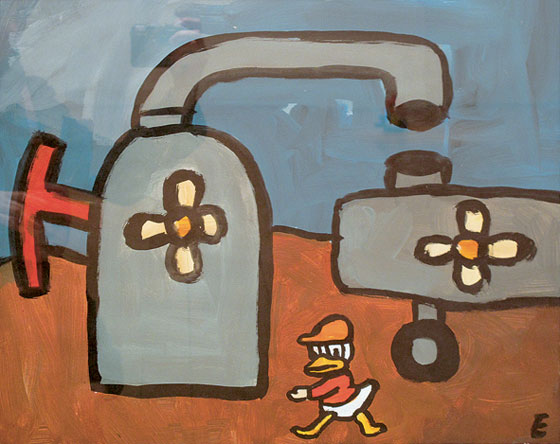 Ernests Kļaviņš. The Well of Syrup. Acrylic on paper. 40x50 cm. 2010 | |
| L.K.: What are your thoughts about the animated television series ‘South Park’? This could be a good example of not following the moderation principle you mentioned – these guys love to exaggerate. The absurd together with satire is one of the series’ favourite combinations. E.K.: I like ‘South Park’! Even if they do exaggerate too much, it’s a part of their artistic technique. What is good about ‘South Park’ is that the connection with reality is kept alive. There are some episodes where questions of a particularly existential nature are discussed, for example, the episode where one of the heroes Stan is in charge of training a hockey team for little children, while one of the team members is suffering from an incurable cancer. It was a bitter episode with a huge serving of emotionality. L.K.: Changing the subject from comics to paintings, I would like to draw parallels with the pop artist Roy Lichtenstein, whose paintings look like images from comic strips. It’s interesting that before turning to pop art, Lichtenstein was painting in a completely different manner. However, once one of his sons pointed to a Mickey Mouse comic book and said: “I bet you can’t paint as good as that, Dad”. Lichtenstein took it as a challenge and so in 1961 his work Look Mickey came into being. Can you tell us how the Disney characters found their way into your paintings? E.K.: My use of pop culture imagery is a fleeting phenomenon and can scarcely be termed a tendency. L.K.: In the Alma Gallery, one of the first works the viewer encounters is a work depicting an animated dwarf, who is carrying a candle and tirelessly never stops going. The caption accompanying the title of the work explains that there is a legend about “…a little dwarf who is carrying a candle through a birch grove. On his way the dwarf is obstructed by branches. If the dwarf were to stumble and fall, and the candle would go out, life on Earth would be destroyed by a gamma ray from the closest star. The dwarf has been going now for several billions of years and has not yet stumbled, so the possibility of stumbling is very high and growing with every second. Perhaps the gamma rays are already coming closer...” The element of science fiction – the gamma ray – raises associations with Bulgakov’s story ‘Fatal Eggs’, where events are similarly influenced by an apocalyptic red ray which becomes the cause of mass human destruction. E.K.: The wave of gamma rays is not a fiction. I have read Bulgakov’s story, but the ray mentioned there is not a gamma ray. L.K.: And what about other scientific motifs, for example, in the work ‘A Caterpillar Enslaves Ants Using Chemicals’? E.K.: This, in turn, is a motif from popular science and also is not an invention. It’s a fact of life, caterpillars like that really exist. The life of insects generally is amazing – no science fiction can ever compare! In this work I’m illustrating the fact that a caterpillar has learnt to discharge something that makes ants serve him. In nature there is also a mushroom that enslaves ants and plants. I read Richard Dawkin’s book ‘The Selfish Gene’ and it contains a lot of examples like these. L.K.: Whereas the animated dwarf had been produced as the magnification of a pixel. E.K.: Yes, the dwarf was pixelated. This was done on purpose, and it is quite a popular animation technique. A digital image consists of numerous pixels and I used this fact as an effect. L.K.: But it doesn’t contain an allusion that you look at your surroundings as if through a microscope, that there is this magnification and a zoomed-in view? E.K.: No, it’s not meant to indicate that the dwarf is very small. To some extent it resonates with the idea about the quantum grid, but I don’t claim that that is something I fully understand. This is a tricky subject, because I’m not very knowledgeable in physics. I have only picked up bits and pieces from popular science. L.K.: Are you very interested in scientific matters? E.K.: Not an enormous deal, but generally yes. | |
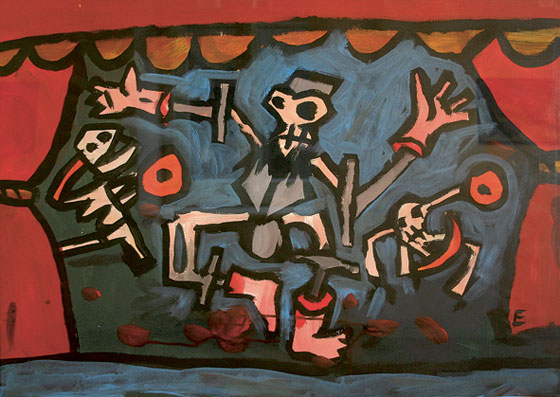 Ernests Kļaviņš. The Ballet. Acrylic on paper. 64x90 cm. 2010 | |
| L.K.: Several works feature the image of fire, which is an apocalyptic image in itself, for example in the works Monument to the Inventor of Fire and Third World War. E.K.: Third World War belongs to my gloomy works. A similar atmosphere can be found in the work A Tree with Faces in Place of Leaves. Towards the end the motifs in my works became quite sad. L.K.: The work Ballet also seems to bear visual similarities to A Tree with Faces in Place of Leaves. E.K.: Yes, these are two of my latest works, which were made in a short period of time. L.K.: Ballet with its grey tonality and Cubist forms reminds me of Picasso’s Guernica, but these again might be my individual associations. E.K.: Picasso definitely would have painted Guernica with different emotions. For me the work is not related to emotionality of such magnitude, it is more a kind of sombre contemplation. L.K.: In an interview Picasso once said: “I have never been out of reality. I have always been in the essence of reality. If someone wished to express war, it might be more elegant and literary to make a bow and arrow because that’s more aesthetic, but for me, if I want to express war, I’ll use a machine-gun!”1 In your works too, things are called by their real names, for example, they show tanks as an integral part of war. E.K.: The tanks were depicted as saucepans and there was a great deal of irony behind that. We have to be able to laugh about terror, too, because it is nearly the only means available of coexisting, if not with the events, then at least with the fact that all kinds of horrors do take place. L.K.: Is it a commentary about where humankind is heading? E.K.: I don’t know. I think that humankind is not under threat of anything bad. Currently we are experiencing unprecedentedly peaceful times and I think that it will continue like that. L.K.: Maybe it was the atomic bomb on Hiroshima that made people come to their senses? E.K.: The more powerful the weapons, the more peace-loving their users. This can be observed in the animal world as well. Wild animals that live in packs are more careful with each other than those who perhaps haven’t got such a powerful arsenal with which to injure each other. L.K.: It is interesting that the Italian Futurists wrote in their manifesto that war is very much needed, as a destructive act, force and energy to liberate mankind from all that is superfluous. They glorified war and wrote that it was the world’s only hygiene, and only after they had actually faced the horrors of war did they understand how wrong their perspective was. E.K.: To me war is probably not such an essential theme that I would reflect upon it a great deal. I can think about history, but the subject is not very important to me, because I am living in peaceful, well-fed times. L.K.: How do you view the revolutions that recently took place in the Middle East? Those people are not experiencing particularly peaceful times... E.K.: Yes, but it doesn’t affect me. Besides, it’s been even worse over there! Nowadays there are local conflicts, but they cannot be compared to total, homicidal war where massės of people are destroyed. Maybe there is something like that going on in Africa, but not in the Middle East. L.K.: And what about the image of Lenin in your works? It featured in two works – Lenin and Lenin Leaves the Station? E.K.: That was something like a stream of consciousness. The image was created with a whistle-shaped head, somewhat sad. To the people of today, Lenin is no longer important. If Stalin may still play some role, Lenin doesn’t at all. In general my imagery is not created by using the logically thinking part of the brain. I usually try to listen to myself, and after a while the images appear somewhere. When the images become more clearly evident, I can either decline or accept them. That’s how the image and title of the Lenin work came into being. My paintings are small in scale, and painted on paper, because that provides me the opportunity to work freely enough. In the end I skim off the works that I don’t like. When working on a painting like this, it’s not such a great risk – if I fail, I can do another and discard this one. L.K.: Do you burn the works you don’t like? Or perhaps manuscripts don’t burn? E.K.: No, I put them into a folder. I have noticed that people usually don’t do very well with their graduation works. It’s because you want to show yourself from all possible sides, and there is this huge tension. I saw the photograph of Anšlavs Eglītis’ graduation work, and that too was very poor, of course. Everything so wooden, and frozen poses. I don’t know what the tendency is today, but when I graduated from various institutions, this stiffness was very evident. | |
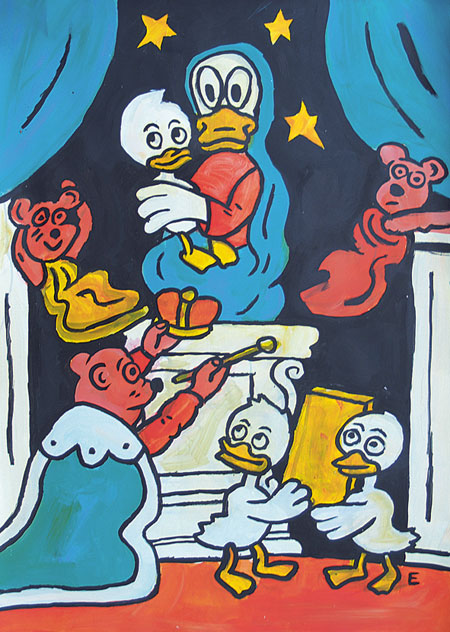 Ernests Kļaviņš. Power is Holy or the Sanctimonious King. Acrylic on paper. 90x64 cm. 2011 | |
| L.K.: What was your graduation work like? E.K.: My Master’s work consisted of greyish, nuanced and expressively painted landscapes. You can see in them the National Museum of Art – trees, trams… As for my Bachelor’s work, I don’t even remember any more. L.K.: Did you continue to paint in the same manner as in your Master’s work afterwards as well? E.K.: Yes, my first exhibition in the Gallery Alma consisted of landscapes. Currently I have returned to the style you can see now – local colours, defined outlines. This has always been characteristic of me, all the time I fluctuate between two modes of painting: expressive and blurry, on the one hand, and clearly defined with localised colour, on the other. Likewise the motifs fluctuate too – either elements of science fiction, like now, and which generally appeal to the viewers more, or everyday landscapes, people, industrial scenes. L.K.: Don’t the works you recently exhibited in the Alma refer to the thick, geometrically imprecise outlines, and intense and bright colours typical of Fauvism? E.K.: Yes, of course, classical Modernism has left its impact. To some degree, I’m moving towards Fauvism. I also like Expressionism. L.K.: Some works also feature a desert theme, for example, The Inhabitants of the Desert and Cactus. It must be admitted, cactuses are plants with quite a phallic form – did you include them in your works intentionally? E.K.: No, it was not meant like that. Initially it was the image of a match with hands and a guitar, which was created for the exhibition Last Match. Then I somehow took a liking to the image and kept it, but it doesn’t contain any deep and special meaning. All the images are like that... With my images, I don’t attempt to say anything important, they aren’t invested with any deep meaning. L.K.: So we shouldn’t read them as symbols. E.K.: No, I’m not too keen on my images being read as symbols, and I’m not a fan of the metaphor. L.K.: What are you currently interested in? E.K.: I’m attracted to the element of interactivity. At the beginning we spoke about paintings being non-linear narratives, whereas a text or film is linear. L.K.: But you can have an avant-garde film with a non-linear narrative! E.K.: In any case, a film is watched from the beginning to the end and the viewer cannot choose in what succession to view the montaged shots. I’m interested in making interactive narratives as in, for example, computer games. This genre could be compared to comics, where, on one hand, there is art-house, and on the other – superheroes, with nothing in the middle. The only difference is the fact that this field is very new. It offers many opportunities, however there’s still a lot of obstacles also. L.K.: Actually in recent years there have been attempts to construct interactive films. E.K.: Yes, there have been, but they could be regarded more as marginal phenomena. L.K.: So interactive computer games is what we can expect from you in future? E.K.: That would be a statement that’s a bit too bold, but by all means it’s one of the things I’m interested in! Ernests Kļaviņš (born 1977) is best known for his caricatures for the magazine ‘Ir’ and online portal ir.lv. From 2000 till October 2009 he drew caricatures and illustrations for the newspaper ‘Diena’. He has also drawn comics for the magazine ‘Kuš’, and together with his brother Andrejs took part in the creation of the comic book ‘3x3’. After attending the Janis Rozentāls Art Secondary School, Kļaviņš graduated from the painting department of the Art Academy of Latvia with a Bachelor’s degree and later obtained a Master’s degree at the same institution. Solo exhibitions: kinetically interactive exhibition Ziemassvētki sabraukuši rakstītām kamanām (Project space of the exhibition hall Arsenāls of the Latvian National Museum of Art, 2002), exhibitions Ainavas un figūras (Gallery Alma, 2008), Viedo akmeņu stāsti (Nabaklab, 2010), Karš starp titāniem un rūķīšiem (Gallery Alma, 2011). Most important group exhibitions: Mūsu laiku ikonas (Gallery Alma, 2009), Tīrība (creative space Tasty, 2009) and Našķu bumba (exhibition hall Arsenāls of the Latvian National Museum of Art, 2007). /Translator into English: Laine Kristberga/ | |
| go back | |







